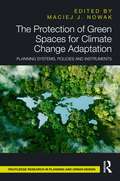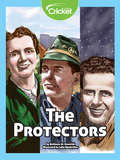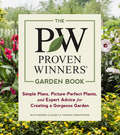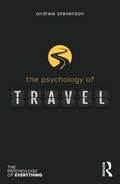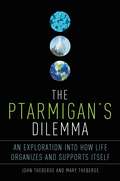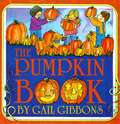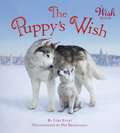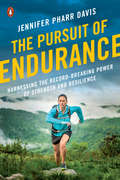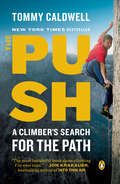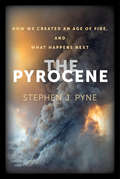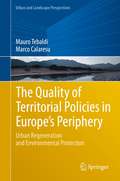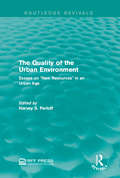- Table View
- List View
The Protection of Green Spaces for Climate Change Adaptation: Planning Systems, Policies and Instruments (Routledge Research in Planning and Urban Design)
by Maciej J. NowakThe Protection of Green Spaces for Climate Change Adaptation identifies how spatial planning and climate change adaptation are linked by examining the protection of green spaces in cities across Europe, Africa, the Middle East, South America and Australia.This book identifies how, in each case, spatial planning instruments can influence the protection of green spaces, and whether – and if so how – they are being adapted in response to actual and expected effects from climate change. In doing so, the institutional frameworks of each country analysed are first presented. This provides the basis for discussing the key problems occurring at the state (and city) level in responding to the challenges of climate change adaptation, especially for the protection of green spaces. In the individual chapters, the issues identified above will be analysed from the perspective of diverse countries: Australia, Ghana, Iran, Mexico, Brazil and Poland. The contributors in this edited collection will present how the indicated issue is identified in systems that are diverse in many respects. This book concludes by demonstrating how the relationship between climate change adaptation and spatial planning can be framed in a more universal way, taking into account the international case studies that have been presented. This book deals extensively with both climate change adaptation issues and comparisons of spatial planning systems.By focusing on a synthesis of these issues, this book will add significantly to the discussion, providing a new basis for theoretical and practical considerations. It will be of interest to researchers and students of spatial planning, public policy, environmental protection, climate protection and law, as well as professionals working in these areas.
The Protectors
by Kathiann M. KowalskiIt takes commitment to overcome interests that stand in the way of protecting the environment. Meet three people who weren't afraid to speak up to protect natural areas—and us.
The Proterozoic in Canada (The Royal Society of Canada Special Publications #2)
by James E. GillProterozoic time produced much of great interest to geologists, and was of tremendous economic import to the people of Canada and the United States. Most of the iron deposits of the Lake Superior district, the Michigan copper deposits, the enormously important Sudbury nickel-copper-platinum deposits, the spectacular silver deposits of the Cobalt district, and all of the important uranium ores in the Shield area are considered to have formed during this period in geological time. Proterozoic rock groups include those Precambrian rocks which are least deformed and metamorphosed. Because of their important economic deposits, they have been examined in great detail in certain localities. The results of such examination, and of others which were for reconnaissance only, are summarized in this volume of the Royal Society of Canada. Suggestions are made for revision of previous interpretations of Precambrian history, and the terminology which grew out of them. Three papers deal with problems arising from the current use of the term Proterozoic, and with possible changes in its use to bring it more into accord with the facts. Contributors to this volume are: E.M. Abraham, Robert Bergeron, R.G. Blackadar, I.C. Brown, G.H. Charleswood, J.F. Davies, K.E. Eade, W.F. Fahrig, R.M. Farquhar, James E. Gill, H.C. Gunning, J.M. Harrison, D.F. Hewitt, W.W. Moorhouse, J.E. Reesor, S.M. Roscoe, R.D. Russell, James E. Thomson, Robert Thomson, L.J. Weeks, Alice E. Wilson, J.T. Wilson, G.M. Wright.
The Proven Winners Garden Book: Simple Plans, Picture-Perfect Plants, and Expert Advice for Creating a Gorgeous Garden
by Thomas Christopher Ruth Rogers ClausenGarden with the confidence of a winner! Proven Winners is America’s #1 plant brand. And now they are sharing their expert plant knowledge and creative design ideas in their first book, The Proven Winners Garden Book. This definitive guide starts with lessons on how to prepare a space, tips on choosing the right design, and a primer on buying the right plants. Twelve garden plans provide simple design ideas that will add curb appeal to your home garden. They include— A welcoming entrywayA butterfly and pollinator gardenA fragrant flower gardenA shady summertime retreatA deer-resistant garden There are an additional twenty-five container recipes that add color and pizzazz to gardens of all sizes—even on balconies and patios. The creative combinations include holiday themes, solutions for shade and other concerns, poolside ideas, and much more.
The Psychology of Collective Climate Action: Building Climate Courage
by Karen Hamann Eva Junge Paula Blumenschein Sophia Dasch Alex Wernke Julian BlehHow do we find the courage to act together against the climate crisis? This book weaves together real-life findings and examples from the socio-ecological movement with psychological research to show how motivation for collective climate action can be built.The book addresses two key questions: how can individuals be motivated to participate in collective climate action, and how can climate groups become resilient and effective? Specifically, it explores how individuals can foster their identification with climate action groups and the belief in their joint efficacy. It touches on a wide range of topics, covering anger, moral considerations, activist burnout, and the perception of protests, as well as general theories of socio-ecological change.This book is for anyone who is seeking the courage to act together and is curious about psychological insights. It will be essential reading for climate and environmental practitioners, climate activists and campaigners, climate change communicators, and anyone involved in socio-ecological change. It will also be of interest to students and researchers in the fields of environmental psychology, climate change, collective action, and political psychology.The Open Access version of this book, available at http://www.taylorfrancis.com, has been made available under a Creative Commons (CC BY) 4.0 license.
The Psychology of Environmental Law (Psychology and the Law)
by Arden Rowell Kenworthey Bilz Linda J DemaineOffers psychological insights into how people perceive, respond to, value, and make decisions about the environmentEnvironmental law may seem a strange space to seek insights from psychology. Psychology, after all, seeks to illuminate the interior of the human mind, while environmental law is fundamentally concerned with the exterior surroundings—the environment—in which people live.Yet psychology is a crucial, undervalued factor in how laws shape people’s interactions with the environment. Psychology can offer environmental law a rich, empirically informed account of why, when, and how people act in ways that affect the environment—which can then be used to more effectively pursue specific policy goals. When environmental law fails to incorporate insights from psychology, it risks misunderstanding and mispredicting human behaviors that may injure or otherwise affect the environment, and misprescribing legal tools to shape or mitigate those behaviors.The Psychology of Environmental Law provides key insights regarding how psychology can inform, explain, and improve how environmental law operates. It offers concrete analyses of the theoretical and practical payoffs in pollution control, ecosystem management, and climate change law and policy when psychological insights are taken into account.
The Psychology of Pro-Environmental Communication: Beyond Standard Information Strategies
by Christian A. KlöcknerThe environment is part of everyone's life but there are difficulties in communicating complex environmental problems, such as climate change, to a lay audience. In this book Klöckner defines environmental communication, providing a comprehensive and up-to-date analysis of the issues involved in encouraging pro-environmental behaviour.
The Psychology of Travel (The Psychology of Everything)
by Andrew StevensonWhy do we travel? Are holidays good for our health? What are the social and psychological factors that drive us to move? The Psychology of Travel provides an eclectic introduction to the range of travel experiences from commuting, to going on holiday, to studying abroad. Travel is a near-universal experience and manifests itself in various forms, from everyday experiences to exotic adventure, although it varies across time and cultures. The book unpacks the concept of travel, and engages with topics including migration, wellbeing, acculturation, wayfinding, slow travel, place attachment and nostalgia, and brings them into sharp focus in relation to globalisation and climate change, By asking what drives us to journey and offering key insights into the psychological factors behind different kinds of travel, The Psychology of Travel introduces the reader to new ways of thinking about global mobility and movement.
The Ptarmigan's Dilemma: An Ecological Exploration into the Mysteries of Life
by Mary Theberge John ThebergeDrawing on breakthrough research in evolution, genetics, and on their extensive work in the field and lab, wildlife biologists John and Mary Theberge explain for non-scientists the real facts of life. Birds that suddenly grow gall bladders, when their species has none. Moose with antlers so big they encumber their movement through the forest. Butterflies that risk extinction by overwintering en masse. These are just a few stories the Theberges tell in their examination of what the mechanisms of evolution are and how they work. With examples from the very latest discoveries in genetics and ones they have made in their own field work, The Ptarmigan's Dilemma is a ground-breaking explanation of evolution for non-scientists. By marrying the separate sciences of ecology and genetics, the Theberges paint a picture far richer than either discipline can alone of how, for almost 4 billion years, life on Earth has evolved into the rich diversity that's under threat today. Along the way, they explain just what "the survival of the fittest" really means, how dramatic evolutionary changes can take place in just one generation, and how our too-little knowledge of or interest in how life on Earth organizes and supports itself is rapidly making us a danger to ourselves.
The Pumpkin Book
by Gail GibbonsDescribes how pumpkins come in different shapes and sizes how they grow and their traditional uses and cultural significance Includes instructions for carving a pumpkin and drying the seeds Gail Gibbons is the well known nonfiction author for children. Other titles include Fire Fire, Apples, Bats, and the Post Office. This book would be a wonderful teaching tool with real pumpkins.
The Puppy Diaries: Living With a Dog Named Scout
by Jill AbramsonOne sparkling summer day, Jill Abramson brought home a nine-week-old golden retriever named Scout. Over the following year, as she and her husband raised their adorable new puppy, Abramson wrote a hugely popular column for The New York Times's website about the joys and challenges of training this rambunctious addition to their family. Dog-lovers from across the country inundated her with emails and letters, and the photos they sent in of their own dogs became the most visited photo album on the Times's site in 2009. Now, Abramson has gone far beyond the material in her column and written a detailed and deeply personal account of Scout's first year. Part memoir, part manual, part investigative report, The Puppy Diaries continues Abramson's intrepid reporting on all things canine. Along the way, she weighs in on such issues as breeders or shelters, adoption or rescue, raw diet or vegan, pack-leader gurus like Cesar Millan or positive-reinforcement advocates like Karen Pryor. What should you expect when a new puppy enters your life? With utterly winning stories and a wealth of practical information, The Puppy Diaries provides an essential road map for navigating the first year of your dog's life.
The Puppy's Wish (A Wish Book)
by Lori EvertThe creators of the bestselling picture book The Christmas Wish bring us another original board book featuring the adorable husky puppy from The Brave Little Puppy.Here is the newest Nordic adventure by the creators of the New York Times bestseller The Christmas Wish—this one as a board book for the littlest listeners. The star of The Christmas Wish, Anja, has an adorable husky puppy named Birki. Birki wishes he were good at something . . . anything! After all, sheep give Anja wool for her clothes, goats and cows give her milk, and the reindeer pull her family&’s sleigh. But what can Birki do? He has the most important job of all—he&’s Anja&’s best friend! Husband-and-wife duo Lori Evert and Per Breiehagen give us another breathtaking photographic adventure set in Per&’s homeland, Norway. In a starred review, Publishers Weekly said of The Christmas Wish, &“Rosy-cheeked Anja looks like she&’s stepped out of a fairy tale, and Breiehagen&’s delicious photographs create the sense that magic is very real.&” Praise for The Christmas Wish: &“Dreams have never been so photogenic.&” —The Children&’s Book Review
The Pursuit of Endurance: Harnessing the Record-Breaking Power of Strength and Resilience
by Jennifer Pharr DavisNational Geographic Adventurer of the Year Jennifer Pharr Davis unlocks the secret to maximizing perseverance--on and off the trailJennifer Pharr Davis, a record holder of the FKT (fastest known time) on the Appalachian Trail, reveals the secrets and habits behind endurance as she chronicles her incredible accomplishments in the world of endurance hiking, backpacking, and trail running. With a storyteller's ear for fascinating detail and description, Davis takes readers along as she trains and sets her record, analyzing and trail-testing the theories and methodologies espoused by her star-studded roster of mentors. She distills complex rituals and histories into easy-to-understand tips and action items that will help you take perseverance to the next level. The Pursuit of Endurance empowers readers to unlock phenomenal endurance and leverage newfound grit to achieve personal bests in everything from sports and family to the boardroom.
The Push: A Climber's Journey of Endurance, Risk, and Going Beyond Limits
by Tommy CaldwellA dramatic, inspiring memoir by legendary rock climber Tommy Caldwell, the first person to free climb the Dawn Wall of Yosemite’s El Capitan "If you want to be inspired by a great leader, if you want to feel what it takes to do what no one thought possible, if you want to be absorbed by a heroic journey--Tommy Caldwell's story is one of the best you could ever hope to find.” – Jim Collins, author of Good to Great On January 14, 2015, Tommy Caldwell, along with his partner, Kevin Jorgeson, summited what is widely regarded as the hardest climb in history—Yosemite’s nearly vertical 3,000-foot Dawn Wall, after nineteen days on the route. Caldwell’s odds-defying feat was the culmination of an entire lifetime of pushing himself to his limits as an athlete. This engrossing memoir chronicles the journey of a boy with a fanatical mountain-guide father who was determined to instill toughness in his son to a teen whose obsessive nature drove him to the top of the sport-climbing circuit. Caldwell’s affinity for adventure then led him to the vertigo-inducing and little understood world of big wall free climbing. But his evolution as a climber was not without challenges; in his early twenties, he was held hostage by militants in a harrowing ordeal in the mountains of Kyrgyzstan. Soon after, he lost his left index finger in an accident. Later his wife, and main climbing partner, left him. Caldwell emerged from these hardships with a renewed sense of purpose and determination. He set his sights on free climbing El Capitan’s biggest, steepest, blankest face—the Dawn Wall. This epic assault took more than seven years, during which time Caldwell redefined the sport, found love again, and became a father. The Push is an arresting story of focus, drive, motivation, endurance, and transformation, a book that will appeal to anyone seeking to overcome fear and doubt, cultivate perseverance, turn failure into growth, and find connection with family and with the natural world.
The Pyrocene: How We Created an Age of Fire, and What Happens Next
by Stephen J. PyneA dramatic reorientation of humanity’s relationship with fireThe Pyrocene tells the story of what happened when a fire-wielding species, humanity, met an especially fire-receptive time in Earth's history. Since terrestrial life first appeared, flames have flourished. Over the past two million years, however, one genus gained the ability to manipulate fire, swiftly remaking both itself and eventually the world. We developed small guts and big heads by cooking food; we climbed the food chain by cooking landscapes; and now we have become a geologic force by cooking the planet. Some fire uses have been direct: fire applied to convert living landscapes into hunting grounds, forage fields, farms, and pastures. Others have been indirect, through pyrotechnologies that expanded humanity's reach beyond flame's grasp. Still, preindustrial and Indigenous societies largely operated within broad ecological constraints that determined how, and when, living landscapes could be burned. These ancient relationships between humans and fire broke down when people began to burn fossil biomass—lithic landscapes—and humanity’s firepower became unbounded. Fire-catalyzed climate change globalized the impacts into a new geologic epoch. The Pleistocene yielded to the Pyrocene. Around fires, across millennia, we have told stories that explained the world and negotiated our place within it. The Pyrocene continues that tradition, describing how we have remade the Earth and how we might recover our responsibilities as keepers of the planetary flame.
The Quality of Territorial Policies in Europe’s Periphery: Urban Regeneration and Environmental Protection (Urban and Landscape Perspectives #22)
by Mauro Tebaldi Marco CalaresuThis book focuses on territorial policies as instruments for local development in Europe’s periphery. Using a multiple-case research design in three typical case studies in the context of the Mediterranean island of Sardinia (Italy), we empirically test the hypothesis that the institutionalisation of the governance system is an independent variable that is capable of influencing the quality of public policy, intended as a dependent variable. According to this hypothesis, the two above-mentioned variables tend to change according to a linear and direct correlation: upward variation of the degree of institutionalisation of the governance system tends to correspond to upward variation in the quality of the policy, and vice versa. In our conclusions, we discuss the descriptive and prescriptive implications of the empirical findings of the research for the local development of peripheral areas. Regarding the descriptive implications, we explain how territorial policy-making can be articulated, based on the degree of institutionalisation of the governance system and the quality of the territorial policies. Regarding the prescriptive implications, we identify the best practices for territorial governance in order to improve the chances of local development in Europe’s periphery.
The Quality of the Urban Environment: Essays on "New Resources" in an Urban Age (Routledge Revivals)
by Harvey S. PerloffThe quality of the environment in which people live, work, and play influences to no small degree the quality of life itself. The environment can be satisfying and attractive and provide scope for individual development or it can be poisonous, irritating and stunting. The papers in this volume, first published in 1969, are concerned with the urban environment – in which the majority of Americans live – or, more accurately, with the environment of urbanites, for the concern extends to outlying areas where urban dwellers visit and play. The chapters aim to provide a better understanding of the natural resource elements in the urban environment, and will be of interest to students of environmental studies and human geography.
The Quarry Fox: And Other Critters of the Wild Catskills
by Leslie T. SharpeReflections on the private lives of the wild critters of the Catskills, from birds to moths to wild deer, by a lifelong naturalist A red fox stands poised at the edge of a woodchuck den, his ears perked for danger as two pudgy fox cubs frolic nearby. A mother black bear and her cubs hibernate beneath a felled tree. A barred owl snags a hapless cottontail from a meadow with its precise talons. In The Quarry Fox and Other Tales of the Wild Catskills, Leslie T. Sharpe trains her keen eye and narrative gifts on these and other New York wildlife through her tales of close observations as a naturalist living in the Great Western Catskills. The Quarry Fox is the first in-depth study of Catskill wildlife since John Burroughs invented the genre of nature-writing, in which Sharpe weaves her experiences with the seasons, plants, and creatures with the natural history of each organism, revealing their sensitivity to and resilience against the splendor and cruelty of Nature. Sharpe's frank, scientific observations join with her deeply felt connection to these creatures to instill in readers an appreciation of the undaunted and variegated beauty of the Catskills and camaraderie with its animals. From contemplating the importance of milkweed for monarchs to lay their eggs to reveling in the first steps of a wobbly fawn, The Quarry Fox is a celebration of the natural world and our place in it.
The Quaternary in the Tropics: A Reconstruction of the Palaeoclimate (Springer Textbooks in Earth Sciences, Geography and Environment)
by Klaus HeineThe Ice Age (Quaternary) is a period of extreme climate fluctuations that led to the growth and melting of massive ice sheets in the high latitudes. Tropical deserts, savannas, rainforests, and mountainous regions experienced equal dramatic climatic changes of which the traces are preserved in sedimentary deposits. The knowledge of tropical climate history is of paramount importance because in the tropics and marginal tropics, natural and - more recently - human-induced processes significantly control global climate. Yet relatively few palaeoclimate records are known from these regions.This book presents the climate archives of the tropics and critically discusses their palaeoclimatic informative value. Based on decades of research the author demonstrates that a lack of geoecological knowledge leads to misinterpretations in modeling climate futures. The results presented here call for a correction of many widely held views about the role of atmospheric greenhouse gases in global warming over the past 150 years.The book is intended for natural scientists of all disciplines who are looking for a synopsis of the problem area "Our climate in the past, present and future in the tropics".
The Queen's Green Canopy: Ancient Woodlands and Trees
by Adrian Houston Charles Sainsbury-PlaiceStunning photographs of the United Kingdom's most spectacular trees - with a foreword by His Majesty the King.The Queen's Green Canopy is a beautiful photography book showcasing 70 ancient trees and 70 ancient woodlands dedicated by the QGC initiative in honour of Her Majesty's Platinum Jubilee.The book features extraordinary photographs of the United Kingdom's best-loved trees, many of which inspired historic figures, artists and writers through the centuries.Alongside these photographs are short written pieces from contributors including Dame Judi Dench, Alan Titchmarsh, Dame Joanna Lumley, Adam Henson, Archbishop Justin Welby and Danny Clarke, as well as conservation experts from the Woodland Trust and the Duchy of Cornwall. In these pieces they reflect on the trees that have made a mark on their lives and the importance of protecting Britain's woodlands for future generations.Selected trees include yews at a Cotswold's church which inspired JRR Tolkien; the apple tree believed to have inspired Sir Isaac Newton's theory of gravity; the Five Hundred Acre Wood in East Sussex immortalised in AA Milne's Winnie the Pooh books; and the 2,500-year-old tree where Henry VIII may have proposed to Anne Boleyn.So far 3 million trees have been planted by communities, schools and businesses across the country as part of the QGC initiative. Through incredible imagery and joyful pieces of writing, The Queen's Green Canopy celebrates Her Majesty's extraordinary life and the amazing legacy she leaves behind.
The Queerness of Water: Troubled Ecologies in the Eighteenth Century (Under the Sign of Nature)
by Jeremy ChowThis highly original book reconsiders canonical long eighteenth-century narratives through the conjoined lenses of queer studies and the environmental humanities. Moving from Daniel Defoe’s Robinson Crusoe and Jonathan Swift’s Gulliver’s Travels to Gothic novels including Mary Shelley’s Frankenstein, Jeremy Chow investigates the role that bodies of water play in reading these central texts.Chow navigates various representations and phases of water to magnify the element’s furtive yet pronounced effects on narrative, theory, and identity. Water, Chow reveals, is both a participant and a stage upon which bodily violation manifests. The sea, rivers, pools, streams, and glaciers all participate in a violent decolonialism that fractures, revises, and reshapes notions of colonial masculinity emerging throughout the long eighteenth century.Through an innovative series of intermezzi, The Queerness of Water also traces the afterlives of eighteenth-century literature in late twentienth- and twenty-first-century film, television, and other popular media, opening up conversations regarding canon, literary criticism, pedagogy, and climate change.
The Quest for Security: Protection Without Protectionism and the Challenge of Global Governance
by Joseph E. Stiglitz Mary KaldorThe essays in this collection boldly confront the quest for security arising from the social, economic, environmental, and political crises and transformations of our century. Joseph E. Stiglitz and Mary Kaldor begin with an expansive, balanced analysis of the global landscape and the factors contributing to the growth of insecurity. Whereas earlier studies have touched on how globalization has increased economic insecurity and how geopolitical changes may have contributed to military insecurity, this volume looks for some common threads: in a globalized world without a global government, with a system of global governance not up to the task, how do we achieve security without looking inward and stepping back from globalization? In each of their areas of expertise, contributors seek answers to questions about how we achieve protection of those people who are most insecure without resorting to economic, military, or mafia protectionism. Some have suggested that the turmoil in the Eurozone "proves" the deficiencies in the welfare state. This book argues that the superior performance of Scandinavian countries arises from their superior systems of social protection, which allow their citizens to undertake greater risk and more actively participate in globalization. Some suggest that we can address terrorism or transnational crimes through the strengthening of borders or long-distance wars. This book develops the proposition that such approaches have the opposite effect and that only through spreading the human security experienced in well-ordered societies can these dangers be managed.This book also examines how these global changes play out, not only in the relations among countries and the management of globalization, but at every level of our society, especially in our cities. It explores the potential for cities to ensure personal security, promote political participation, and protect the environment in the face of increasing urbanization.
The Quest for the Sustainable Development Goals: Living experiences in territorializing the 2030 Agenda in Brazil (Sustainable Development Goals Series)
by Thiago Gehre Galvao Henrique Zeferino de MenezesThe book presents the experiences, complexities, and contradictions of the implementation of the Sustainable Development Goals in Brazil so far. Through chapters from a variety of stakeholders, the book examines national, regional, and local aspects of development in Brazil. The chapters here draw from scientific knowledge and practical experience to take a critical look at what the SDGs mean in a Global South country and what the implications of this are for global development. The book is divided into three sections. The first section addresses the critical political and institutional aspects related to the implementation of the Sustainable Development Goals in Brazil, highlighting advances as well as pitfalls and setbacks. The chapters look at broad questions related to the role of civil society in defining political priorities and strategies to move forward with the SDGs as well as issues involved in incorporating the SDGs at different levels of government and other institutions. The chapters in this section critically address the political and institutional advances as well as barriers to the progress of the SDGs in Brazil. The second section directly addresses progress made toward the SDGs in the context of the political, economic and social variables specific to Brazil. The chapters address critical shortcomings and demands for Brazilian society: the need for improvements in education and employment policies to reduce poverty, the urgent need to increase gender equality and reduce violence, as well as the imperative to strengthen institutions and policies to mitigate climate change and protect the environment. The final section focuses on critically assessing the 2030 Agenda itself and drawing from a Global South IR perspective. The chapters here dialog with decolonial and post-developmentalist perspectives to highlight problems with the agenda and lift up sidelined priorities, presenting yet-unexamined policy solutions and innovations that are currently absent from the global institutional agenda. The Brazilian case is a perfect illustration of how underdevelopment and political instability can constrain the paths to sustainable development, while at the same time social innovations, leverages based on regional dynamics, and strength from social and cultural diversity can drive sustained progress.
The Quest for the Tree Kangaroo: An Expedition to the Cloud Forest of New Guinea (Scientists in the Field Series)
by Sy Montgomery Nic Bishop<P>It looks like a bear, but isn't one. It climbs trees as easily as a monkey- but isn't a monkey, either. It has a belly pocket like a kangaroo, but what's a kangaroo doing up a tree? Meet the amazing Matschie's tree kangaroo, who makes its home in the ancient trees of Papua New Guinea's cloud forest. And meet the amazing scientists who track these elusive animals. <P>[This text is listed as an example that meets Common Core Standards in English language arts in grades 4-5 at http://www.corestandards.org.] <P><P> Winner of the Sibert Honor
The Quest of the Robo-Mermaid (Fountas & Pinnell Classroom, Guided Reading)
by Pamela DellNIMAC-sourced textbook. THE AMAZING ROBO-MERMAID. Imagine going on an ocean dive that takes you so deep no human being could do it without risk of injury or even death. OceanOne, a "robo-mermaid," is how a robotics scientist and an underwater archeologist managed to make that dive happen.
